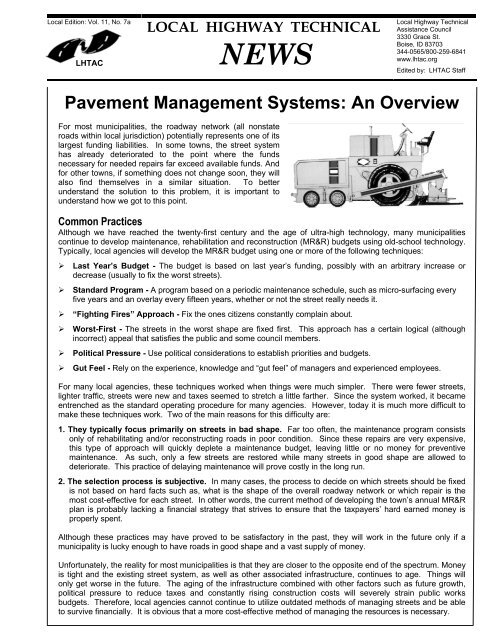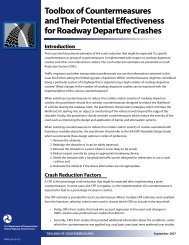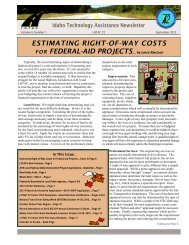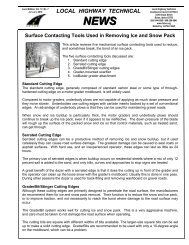Pavement Management Systems: An Overview - Local Highway ...
Pavement Management Systems: An Overview - Local Highway ...
Pavement Management Systems: An Overview - Local Highway ...
You also want an ePaper? Increase the reach of your titles
YUMPU automatically turns print PDFs into web optimized ePapers that Google loves.
A Solution:So how do we cost-effectively manage the maintenance of municipal streets? Unfortunately, there are no magicblack boxes or crystal balls to provide the answer to this difficult question. However, a system must be developedwhere decisions are based on a rational, systematic method of analyzing good information which producesconsistent results. This can only be accomplished using a formalized decision making process such as apavement management system. That is why the Baystate Roads Program strongly suggests the use of apavement management system (PMS) to assist in developing cost-effective budgets. A PMS, if properlyimplemented, will allow a community to maintain its street system as efficiently as possible by providing anational, systematic approach to road surface maintenance.What is a PMS?Although many people think of a PMS as simply a computerprogram, it is much more than that. A PMS is a formalizedprocess that provides decision makers with the informationnecessary to make good investments with the taxpayers’money. This program should include a systematic, consistentapproach to evaluate the present condition of each pavementsurface, determine the proper type of maintenance to returnthe pavement to an acceptable level of service, prioritizenecessary repairs, and generate useful reports.The complexity of a PMS can vary greatly. At the ultra, hightechend of the spectrum, an optimization-type PMS will beable to determine the best investment strategy (as defined bythe agency) every year for an extended number of years. This type of system will be able to analyze manydifferent “what-if” scenarios to determine what will happen to the overall condition of the network due to suchthings as a change in the level of funding or the type of MR&R strategies used. Such a high-tech system requirestremendous amounts of data which are very expensive and time consuming to collect. This can only be justifiedby a large agency such as a state DOT.At the other end of the spectrum, is the simple manual method using a pencil and paper. The only significant costis manpower required to gather some basic data. This type of system is better than nothing, since it does recordthe condition of each road segment. However, most municipalities need additional information such as theassociated costs of all repairs, etc. Since this type of information can be easily generated using a simplified PMSwhich utilizes an inexpensive, easy-to-use “low-tech” computer program to store and analyze data, a manualmethod should be considered only as a last resort.It would be beneficial if all municipalities could have a state-of-the-art PMS, but for most local agencies, it is notpractical. Luckily, a simplified PMS using a “low-tech” computer program will do just fine for the majority of localagencies. Obviously, a simplified PMS will not optimize investment over a five or ten year period. However, it willbe based on the basic principle of selecting the proper MR&R technique and applying it at the correct time.Therefore, a basic PMS will provide the basic information necessary to assist local agency personnel to makeintelligent, informed decisions.The Basic Process:The process can vary greatly depending upon the needs and wishes of the individual agency. At least in thebeginning, it is probably better to keep it relatively simple. <strong>An</strong>y PMS should include the following six basic steps:1) Form a PMS steering committee to oversee the implementation of a PMS. This is crucial to ensuring that aPMS will be successfully implemented. If everyone does not work toward the common goal of trying to developa system that will produce a cost-effective MR&R plan, the chances of success will decrease proportionally tothe amount of resistance.2) Gather all pertinent information about each segment in the road network such as the length, width, surfacetype, etc. (referred to as the road inventory survey).3) Design a systematic method of gathering all relevant information pertaining to the condition of all road surfacesin the network (referred to as a distress survey).4) Develop repair strategies - using the cost and expected life of the various MR&R techniques, determine themost efficient repair based on the needs of the community.5) Determine when to do the maintenance.6) Budget funds that focus on preventive maintenance so as to prevent major deterioration from occurring.
Since there is usually an organizational resistance to change, it is imperative that the initial implementation of aPMS be as successful as possible. Therefore, the initial system should be fairly simple to ensure this goal. As anagency becomes more comfortable with the process and moves up the learning curve, the process can becomemore complex as needed.What Type of Information is Generated?The main goal of a PMS is to provide the information required by the decisionmakers to determine how to cost-effectively maintain the road network. Withthis goal in mind, a basic PMS should be able to generate a series of reportsthat include the following:1. Road Inventory - contains a list of each road segment in the network alongwith the physical characteristics of each segment. It would includeinformation such as the length, width, type of road surface, traffic volume,etc. for each road segment.2. Condition Summary - A summary of the condition of each pavementsurface (results from the distress survey).3. Repair Strategies - A summary of all appropriate MR&R techniques required to improve each road segment inthe network, listed in alphabetical order. The selection of the appropriate MR&R for each road segment isbased on the particular type or types of surface distress that are present.4. Prioritized Repair Strategies - A summary similar to the Repair Strategies Report, except that the order inwhich road segments are listed is based upon a prioritization scheme. In other words, the road segment whichshould be repaired first is listed first and the road which should be fixed last is listed last. Prioritization is basedon certain weighted factors such as traffic, roughness and surface distresses. Selection of the weighting factorsshould be based upon the specific needs of the municipality.5. Budget Reports - Typical reports could include: how many streets can be repaired based upon a specifiedbudget, and how much it would cost to upgrade all streets, etc.What PMS Should We Use?When starting out, it is best to implement a system that is basic in nature, easy-to-use, but still provides thenecessary information to make prudent investment decisions. What local agencies need is a method that meetsthe following criteria:1. It is easy to learn and apply because most decision makers have little or no formal technical training.2. It must be systematic and provide an organized approach to assure that all essential factors are taken intoaccount.3. It must be practical. Taking care of roads and streets is an ongoing real life activity. Therefore, the processmust be both workable and realistic.4. It must be understood and accepted by the local board. A total commitment to the program is vital to make itwork.The Baystate Roads Program recommends that municipalities strongly consider using the Road Surface<strong>Management</strong> System (RSMS) developed by the New Hampshire T2 Center because it was developed to meet thefour requirements stated above. It is a time-tested system that has been used successfully by many municipalitiesthroughout the United States. The Road Surface <strong>Management</strong> System and the Sign Inventory <strong>Management</strong>System (SIMS) are distributed together in a CD called PWMS Distribution. The CD contains the latest RSMSsoftware, the manual, a sign handbook, and other information for a small fee. Please visit the New Hampshirewebsite for complete details: www.t2.unh.edu. Please call Jim Zier at LHTAC for assistance.Quality ControlAll required MR&R and other activities such as utility work in the roadway must be properly constructed to ensurethat they last as long as possible. In addition, new roads must be required to meet reasonably high qualitystandards. A poorly built road can deteriorate quickly and, thereby, become a money pit that will drain themunicipality of precious funds for many years to come. Since the costs of these additional maintenance problemsdue to poor quality work must be added to the already strained maintenance budget, the results could bedevastating. Therefore, any successful PMS must include a quality control program to ensure that all roadsurfaces stay in good shape for as long as is cost-effectively possible.Reference: Baystate Roads Program, Massachusetts LTAP, Tech Note #38, Summer 2005






